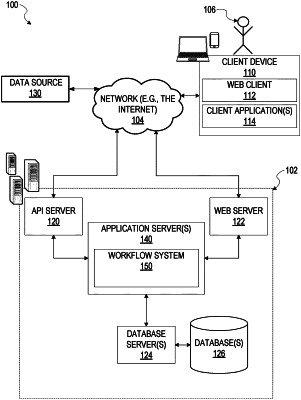| CPC G06F 16/93 (2019.01) [G06F 16/2272 (2019.01); G06F 16/951 (2019.01); G06F 3/04842 (2013.01); H04L 67/01 (2022.05)] | 20 Claims |

|
1. A system comprising:
one or more computer processors;
one or more computer memories;
a set of instructions incorporated into the one or more computer memories, the set of instructions configuring the one or more computer processors to perform operations, the operations comprising:
receiving a workflow definition at a server;
receiving a set of data-object types to assign a workflow in the workflow definition;
based on a receiving of a generation request for a data-object, generating a presentation of a graphical user interface at a client device that includes a display of one or more user selectable options from among a plurality of user selectable options, the one or more user selectable options including one or more fields for receiving a user input, the user input comprising a payload file for the data-object;
generating the data-object based on the received payload file;
assigning a data-object state to the data-object based at least in part on the received payload file, the data-object state being a first data-object state of a plurality of data-object states, the plurality of data-object states further including a second data-object state, the first data-object state being associated with a first set of actions performable to the data-object, the second data-object state being associated with a second set of actions performable to the data-object, the first set of actions being different from the second set of actions; and
altering, based at least in part on the assigned data-object state, the presentation of the graphical user interface to include the data-object.
|